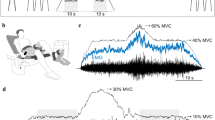Summary
We studied the EMG activity of biceps and triceps in human subjects during isometric force adjustments at the elbow. Rapid targeted force pulses exhibited stereotyped trajectories in which peak force was a linear function of the derivatives of force and the time to peak force was largely independent of its amplitude. These responses were associated with an alternating triphasic pattern of EMG bursts in agonist and antagonist muscles similar to that previously described for rapid limb movements. When the instructions demanded rapid force pulses, initial agonist bursts were of constant duration, and their magnitude was strongly related to peak force achieved. The timing of EMG bursts in antagonist pairs was closely coupled to the dynamics of the force trajectory, and the rising phase of the force was determined by both agonist and antagonist bursts. When peak force was kept constant and rise time systematically varied, the presence and magnitude of antagonist and late agonist bursts were dependent on the rate of rise of force, appearing at a threshold value and then increasing in proportion to this parameter. It is proposed that antagonist activity compensates for nonlinearity in muscle properties to enable the linear scaling of targeted forces which characterizes performance in this task.
Similar content being viewed by others
References
Bouisset S, Lestienne F (1974) The organization of a simple voluntary movement as analysed from its kinematic properties. Brain Res 71: 451–457
Burke RE, Rudomin P, Zajac FE (1976) The effect of activation history on tension production by individual muscle units. Brain Res 109: 515–529
Desmedt JE, Godaux E (1977) Ballistic contraction in man: Characteristic recruitment pattern of single motor units of the tibialis anterior muscle. J Physiol (Lond) 264: 673–693
Evarts EV (1974) Precentral and postcentral cortical activity in association with visually triggered movement. J Neurophysiol 37: 373–381
Freund H-J, Budingen HJ (1978) The relationship between speed and amplitude of the fastest voluntary contractions of human arm muscles. Exp Brain Res 31: 1–12
Ghez C, Vicario D (1978) The control of rapid limb movement in the cat. II. Scaling of rapid force adjustments. Exp Brain Res 33: 191–203
Ghez C (1979) Contributions of central programs to rapid limb movement in the cat. In: Asanuma H, Wilson VJ (eds) Integration in the nervous system. Igaku-Shoin, Tokyo, pp305–320
Ghez C, Martin JH (1982) The control of rapid limb movement in the cat. III. Agonist-antagonist coupling. Exp Brain Res 45: 115–125
Hallett M, Shahani BT, Young RR (1975) EMG analysis of stereotyped voluntary movements in man. J Neurol Neurosurg Psychiat 38: 1154–1162
Henneman E, Mendell LM (1981) Functional organization of motoneuron pool and its consequences. In: Brooks VB (ed) Motor control. (Handbook of Physiology, Sect I, Vol II, pp 423–507). American Physiological Society, Bethesda
Lestienne F (1979) Effects of inertial load and velocity on the braking process of voluntary limb movements. Exp Brain Res 35: 407–418
Marsden CD, Obeso JA, Rothwell JC (1983) The function of the antagonist muscle during fast limb movements in man. J Physiol (Lond) 335: 1–13
Partridge LD (1965) Modification of neural output signals by muscles: A frequency response study. J Appl Physiol 20: 150–156
Wachholder K, Altenburger H (1926) Beiträge zur Physiologie der willkürlichen Bewegung. 10 Einzelbewegungen. Pflügers Arch Ges Physiol 214: 642–661
Waters P, Strick PL (1981) Influence of ‘strategy’ on muscle activity during ballistic movements. Brain Res 207: 189–194
Author information
Authors and Affiliations
Additional information
Supported by the Dystonia Medical Research Foundation and NS 19205
Rights and permissions
About this article
Cite this article
Gordon, J., Ghez, C. EMG patterns in antagonist muscles during isometric contraction in man: Relations to response dynamics. Exp Brain Res 55, 167–171 (1984). https://doi.org/10.1007/BF00240511
Received:
Accepted:
Issue Date:
DOI: https://doi.org/10.1007/BF00240511




